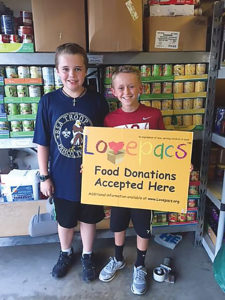People move to Frisco, literally by the thousands every year because it is a thriving, affluent community with so many things to offer. But, did you know that around 1,000 children in Frisco alone have worried about where they were going to get their next meal during a school break? It is a very real problem — one that Lovepacs aims to end through their tremendous and ongoing work.
It all started in 2011, when five families in The Colony discovered that six children at Camey Elementary School were being sent home with backpacks full of food because they would not be able to eat over the weekend otherwise. The families realized those same kids would also be without food for a week during the Thanksgiving holiday. It started so simply — a plea to family and friends to help provide for these kids in need. Katie Hobbs, one of the founders of Lovepacs, says, “We put an ask out through email and on our personal Facebook accounts to say, ‘Hey, there are some kids who will not have food over the holiday break.’”
The plea was answered in a big way. Mrs. Hobbs says, “All of our porches were overflowing with food. We felt like we had more than enough.” They met with the counselor to see if they could help other kids. Not only were they able to provide boxes containing enough food to give the six children two meals a day (plus snacks) over the nine-day break, but they received enough food to make 46 boxes. Neighbors gathered to sort and pack the food, and the very first Lovepacs event brought volunteers from all walks of life together to help provide for others.
The group did some research and realized the children they knew about were not the only ones in desperate need. They worked with the counselor of Camey Elementary School and word quickly spread. By Christmas break, they were packing boxes for 200 children, and the following spring break, their program helped feed around 120 children.
The five founding families eventually moved to different areas, but their efforts did not falter. Lovepacs now has grass root efforts in seven cities, including Aubrey, Austin, Cy-Fair, Frisco, Lewisville, Little Elm and Plano.
When Mrs. Hobbs and her husband, Ryan, moved to Frisco, they talked with Mayor Maher Maso through their church and learned about the child homeless problem that a lot of people are not aware of. It weighed heavily on their hearts. They knew they needed to continue what they started in The Colony. Their first Frisco delivery was in 2013, for spring break. Since it was their first time working with Frisco counselors, they started with about 40 boxes. Mrs. Hobbs says, “We are so blessed to live where we do because the Frisco ISD does everything they can for their kids.” And the Hobbs’ knew how to help a little bit more.
Jennifer Chandarraju and her family moved to Frisco in 2013 from Iowa. Fate brought Mrs. Chandarraju to Lovepacs, as she and Mrs. Hobbs had sons who were in the same fourth grade class. They became friends and wanted to play. Mrs. Chandarraju says, “Katie said she needed volunteers for Lovepacs, and I did not know what it was. I knew Katie and thought it would be a good way to get to know her better. I signed up, helped out and learned about it. That is when they had their Christmas delivery, and that is when I changed what I wanted to do. Katie and I were in the car delivering boxes to the schools and I was overwhelmed with how many kids really needed it. From there on out, I knew this was something I needed to do.”
Mrs. Hobbs says, “We learned very quickly that it is not just about feeding the kids. It is about feeding the community, and we changed our mission statement to reflect that.”
After establishing themselves in 2013 within Frisco schools, Mrs. Hobbs says, “We decided to ‘go big or go home.’ We opened ourselves to all Title I schools in Frisco and there were 11.” The box count quickly went from 40 to 350. “Which we had never done before,” Mrs. Hobbs adds lightheartedly.
How does it work? The North Texas Food Bank has a program to provide children in need with food over the weekends, but holidays and extended breaks are still a problem. (Incidentally, the North Texas Food Bank had to drop their service to Frisco, so Frisco FastPacs stepped in as a sister organization to Lovepacs to take care of weekend needs). Counselors work with Lovepacs to figure out how many children are in a home and provide a total headcount, and from there, Lovepacs gets to work. Mrs. Hobbs says,  “Counselors contact the guardians or parents and they have two-and-a-half days to pick up. We deliver on Wednesday, and they have until the end of the day Friday to pick up.” In case the families do not have transportation, the group partnered with the Frisco Police Department and their Citizens on Patrol program to make sure no one goes without because they could not arrange a pick up. Each box is packed with enough food for each child in the family to have two meals a day, plus snacks!
“Counselors contact the guardians or parents and they have two-and-a-half days to pick up. We deliver on Wednesday, and they have until the end of the day Friday to pick up.” In case the families do not have transportation, the group partnered with the Frisco Police Department and their Citizens on Patrol program to make sure no one goes without because they could not arrange a pick up. Each box is packed with enough food for each child in the family to have two meals a day, plus snacks!
Currently, Lovepacs makes between 430 and 450 boxes each brea, which is enough to help around 1,000 children … and that is just in Frisco! With more people moving to the area every year, that number is likely to grow. The organization is open to all Frisco schools that might have children in need. The last count of schools included 27 elementary, middle and high schools.
How can Frisco residents get involved? The ways are many and only limited by your time and creativity. Boy and Girl Scout troops hold donation drives; neighborhoods host food scavenger hunts; families (with kids in tow) can host packing parties; kids make cards to cheer families up when they open their packages at home (at least one donated book goes in every box) and much more. “A lot of our information spreads by word-of-mouth, honestly,” says Mrs. Chandarraju. “I will go ask companies or send letters to groups who do food drives, and they tend to help out, once they have heard about it.” Lovepacs also makes sure to communicate everything they can through their Facebook page.
Lovepacs accepts food donations, time donations (for packing and sorting) and financial donations. Mrs. Chandarraju says, “It takes lots and lots of volunteers.” Mrs. Hobbs adds, “For our Christmas packing, the volunteer count was just more than 400 people. It takes a village, literally. Since the actual food bank is in my garage, this is something that we can do with more people. There are a lot of awesome teenagers who have come up with their own service projects and come to me to say they did a drive on their own.” These teenagers often deliver completed boxes, ready for drop off at schools.
Lovepacs does have to sort food to remove anything that has expired. Mrs. Hobbs says it breaks her heart to see food go to waste. “We found a great local food bank called ‘Metro Relief,’” she shares. There, expired food is given away, for free, instead of it counting against someone’s food bank points. It is an extra effort to make sure nothing is wasted and as many people as possible can have something to eat.
It is important to note that as much as Lovepacs would love to be able to provide a home-cooked meal to these children, they have to be practical. Because Lovepacs does not interact directly with families, they do not make assumptions about what can be prepared. They focus primarily on providing easy-to-prepare, shelf-stable foods. For meals, they seek out pop-top canned goods, peanut butter, jelly, fruit cups, applesauce, single servings of pasta (SpaghettiOs or Easy Mac) and ramen noodle packages. Bread is donated or purchased just before drop off times, to keep it as fresh as possible. For snacks, they try to gather dried fruits, boxes of single-serve pretzels, Goldfish®, animal crackers, cracker sandwiches, trail mix and other similar items. Mrs. Hobbs says, “Ramen noodles seem to be the favorite. That seems to be the one thing counselors tell us kids request.” Of course, it is hard to go wrong with snacks!
Lovepacs provides a wonderful community service project to get the whole family involved. “We welcome all ages. We have had people bring in baby carriers, set them down and start packing. We have had toddlers walking around holding a can. That is one of the reasons we started this. When we originally started, it was something for our kids to understand, to be a part of and to grow up with,” Mrs. Hobbs says. “You are helping children who deserve a little reassurance to know that food is not something they need to worry about. It teaches so many important lessons, no matter the age. It helps people remember to be grateful for what they have, to help those who are less fortunate and to be kind to their peers, even though they may be different.”
There are many driving factors that keep volunteers involved in the organization. “I look at my three kids and we can talk about how if they went without food, it would be really bad,” Mrs. Chandarraju says. “I do not think they realize it until they say they are hungry.” She uses that as an opportunity to reinforce what they do with Lovepacs and the impact it has for kids just like them. “The stories from counselors and the community are amazing,” Mrs. Hobbs adds. “The bonds that I have made, the growth I have seen and to watch God work is beyond expectation.”
it would be really bad,” Mrs. Chandarraju says. “I do not think they realize it until they say they are hungry.” She uses that as an opportunity to reinforce what they do with Lovepacs and the impact it has for kids just like them. “The stories from counselors and the community are amazing,” Mrs. Hobbs adds. “The bonds that I have made, the growth I have seen and to watch God work is beyond expectation.”
Lovepacs also helps people pick up on signs that a child may have food insecurities. These are signs you can look for in your own schools. If you notice a child who hoards food, attempts to save food for later, eagerly asks when their next meal or snack will be, complains often about being hungry, has difficulty concentrating in class, rushes in line for the cafeteria, eats rapidly, asks for seconds or is frequently sick, contact the school’s counselor to make sure the student has been identified. From there, the counselor can determine the need and contact Lovepacs, if necessary.
Lovepacs provides a chance to help make a difference in a local child’s life. To learn more about volunteer opportunities or to make a donation, go to lovepacs.org.


